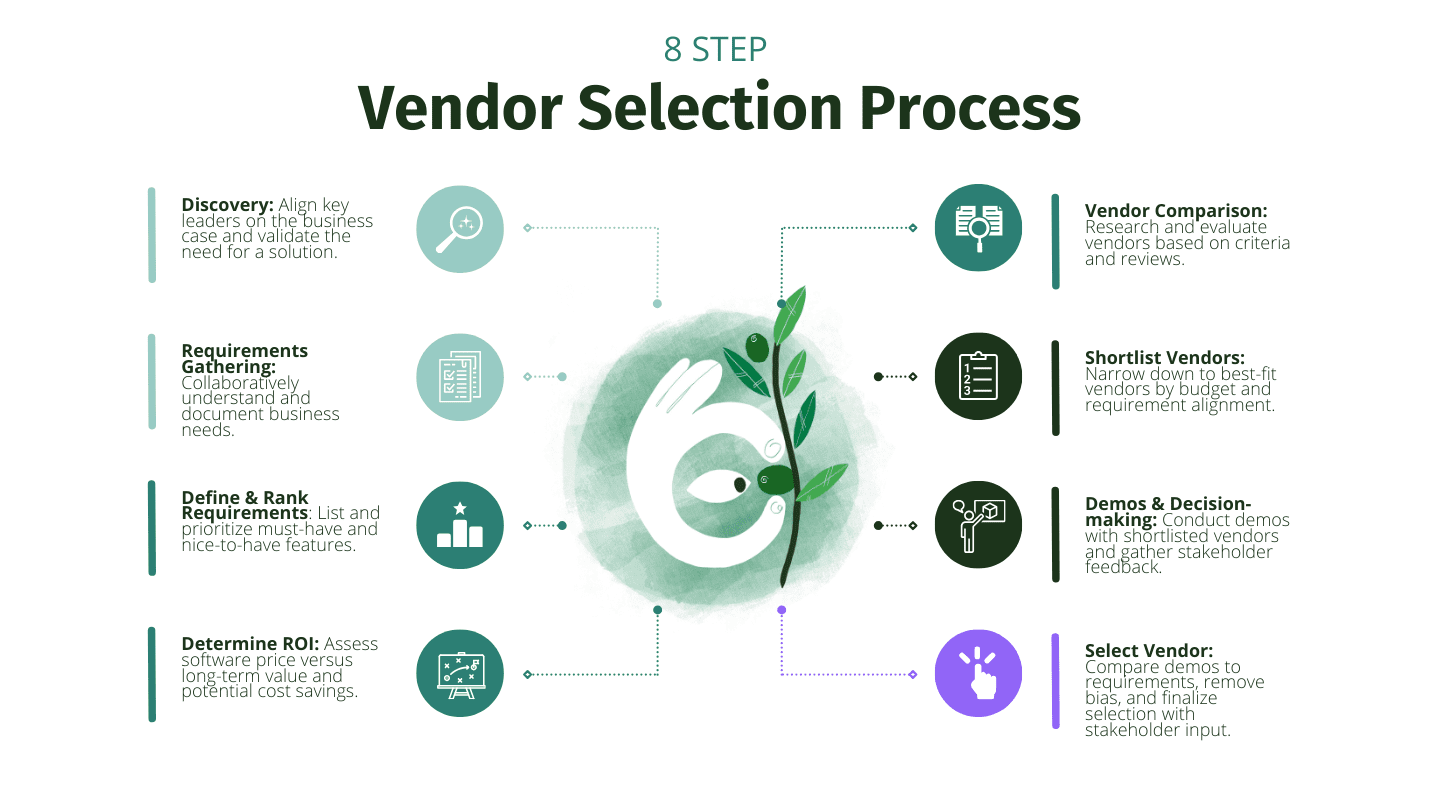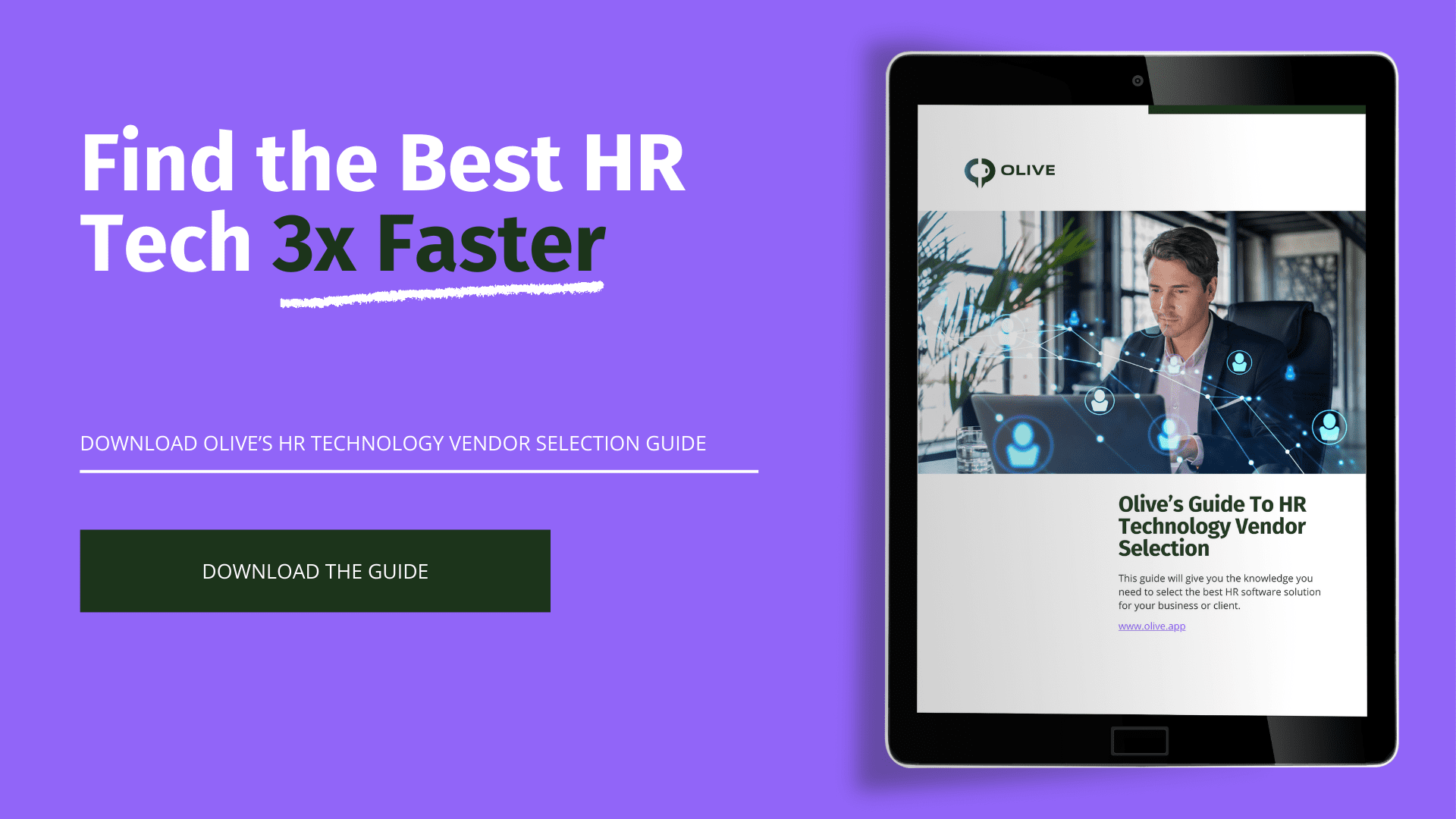Streamlining Software Vendor Selection
You’ve spent months evaluating vendors, only to face issues during implementation. User adoption is low, the vendors over-promise and under-deliver, or a crucial stakeholder is missed during the selection process. You’re not alone! At Olive, we constantly hear about the painful software vendor selection process. Many PMs, CIOs, and consultants tell us they follow a rigid, dated waterfall process: going to big analyst sites, picking the top few solutions, and then shoe-horning the one that seems to be the best fit.
Vendor selection can be daunting and frustrating, with many organizations facing challenges such as poor user adoption, unmet expectations, and missed stakeholder requirements. At Olive, we understand these pain points, which is why we advocate for a different approach. Our philosophy is simple: lead with the business needs first and leverage the power of AI to streamline the process.
What is software vendor selection?
Software vendor selection is the process of identifying and choosing the most suitable vendor or software solution to meet an organization’s specific business needs. It involves evaluating and comparing various vendors based on factors such as functionality, cost, security, integration capabilities, and alignment with the organization’s overall goals.
What is the best method for selecting vendors?
Instead of following rigid and dated waterfall processes, organizations can adopt a more dynamic approach that involves analyzing vast amounts of data and user feedback. The selection process becomes more efficient, accurate, and future-proof by prioritizing the alignment of vendor solutions with the organization’s specific requirements and goals.
The Three Stages of Vendor Selection
-
Discovery and Business Case
- Determine a Business Case: Align key leaders on the business case for a new solution. Assess potential benefits and validate the need for it using Olive’s AI to analyze your business case and provide data-driven insights.
- Key Questions: What are your business goals for the next year? What areas are growing or shrinking? How could the right solution benefit our company? Do we have the right budget?
-
Requirements Gathering and Vendor Comparison
- Understand Business Needs: Collaborate with critical decision-makers to create a ranked list of requirements, including must-haves and nice-to-haves. Use Olive to categorize requirements accurately.
- Collaborate on Requirements: Define must-have requirements (cost, functionality, security, integrations) and nice-to-have features. Rank them to guide your research and demos.
-
Demos and Decision-making
- Shortlist Vendors: Use Olive’s AI to evaluate and score potential vendors based on your requirements. Shortlist those that best meet your needs.
- Conduct Demos: Schedule demos with shortlisted vendors, ensuring key functionalities and use cases are covered. Survey stakeholders for feedback.
- Make the Decision: Compare finalists against your ranked requirements to ensure the chosen solution aligns with your business needs and goals.
The Role of RFPs in Vendor Selection
A Request for Proposal (RFP) is a crucial document in the vendor selection process. It helps outline your business requirements, project scope, and expectations, ensuring vendors provide tailored solutions that meet your specific needs. For more detailed insights on creating effective RFPs, refer to our blog RFP Process: A 7 Step Guide to Success.
Traditional RFP and Vendor Selection Methods
Gone are the days when systems were built for specific problems. Now, there are off-the-shelf enterprise software solutions for almost every business process. With so many options, finding the right vendor for your unique business needs can be like finding a needle in a haystack. The traditional waterfall process of determining needs and comparing them to solution options is difficult, often leading to skipped steps and poor outcomes. While traditional RFPs can take ages to complete, they provide significant value in ensuring you select the best vendor for your needs. They help ensure that all requirements are documented and considered, providing a structured approach to vendor selection.
AI’s Impact on Vendor Selection
AI helps enterprises break free from traditional methods, offering a dynamic approach that analyzes vast amounts of data and user feedback. Olive’s AI algorithms identify innovative and tailored solutions, making the vendor selection process efficient, accurate, and future-proof. AI can guide you through the RFP process, using your own data to make the selection, but in a more agile and streamlined way. By integrating AI into the RFP process, organizations can quickly sift through large volumes of vendor data, identify the best matches for their needs, and make more informed decisions.
8-Step Vendor Selection Process for for a Thorough Evaluation
1. Discovery – Determine a Business Case for the Solution Required
A business case ensures your company realizes measurable business benefits. Ensure key leaders are aligned on the business case. Describe the business challenge and assess the potential benefits of the solution investment to validate your need for it. Olive’s AI can analyze your business case, assess potential benefits, and validate the need for a new software solution. This helps establish clear vendor selection criteria from the outset.
2. Requirements Gathering – Understand the Needs of the Business
Understanding your business needs is a crucial step in the process of buying software. Ensure that the identification of these needs is ideally a collaborative process between critical decision-makers.
Key Considerations:
- What are your business goals for the next year?
- What areas of the business are growing, and what areas are shrinking?
- How could the right solution benefit our company?
- Do we have the right budget for our needs?
- What does success mean to our business?
Answering these questions will help you determine your business needs and develop your vendor selection criteria. Ensure all stakeholders think critically about these needs. Traditionally this work is done in spreadsheets and by hosting multiple meetings. However, business needs often change over time, and even throughout the evaluation. The traditional method of ‘a moment in time RFP’ is outdated. You need to be able to pivot to your business needs, to allow for flexibility over time. Olive’s agile platform allows just that. AI-powered tools help you understand and define your business needs more effectively. Olive’s platform uses natural language processing (NLP) algorithms to analyze and categorize requirements, ensuring a comprehensive and accurate understanding. This saves time, eliminates human error, and enables collaboration among stakeholders.
3. Collaborate to Define and Rank Your Requirements List for the Software Vendors
When you and your team are clear and aligned on what your business needs are, the next step is to rank and define your must-have requirements list, the non-negotiables that the software solution must have, including but not limited to:
- Cost
- Functional requirements
- Security
- Integrations with current enterprise software infrastructure
When you have defined your must-haves, you can then take a look at your nice-to-have requirements. This may include:
- User Experience
- White labeling and branding
- Mobile platform
This should be a collaborative effort amongst the team. When you begin the process, make the list as long as possible, and then rank and define the list according to needs. This ranked list will act as your guide when you begin researching options and demoing products. These requirements form the foundation of your vendor selection criteria.
When ranking this list, it’s important to consider:
What can we afford?
What sort of accessibility do you need the solution to have?
Does the vendor provide an implementation plan and support?
- What are the shortcomings of the current solution?
- What technical features do we need the solution to have?
- What workflows must the new software incorporate?
- What problems should the new solution solve?
4. Determine the ROI on the Right Solution
Determine the ROI on the right solution by looking at the software price vs. software value. There may be many cost savings down the line if you are successful in finding the best software for your business needs. This value is often overlooked. Think about the return on investment that the right solution would provide to the whole company. Often, a solution that is cheaper in the short term, ends up being way more costly in the long term. Sometimes a more costly solution is needed for true innovation. Evaluating ROI based on your vendor selection criteria ensures you choose a solution that delivers long-term value.
5. Software Vendor Comparison
This stage of the process should be to list as many vendors as possible within your bandwidth that meet the general requirements of what you are looking for—research online for solutions in the space.
Reviews can be helpful in looking at the product from a user’s perspective. You can glean some great insights from online reviews such as what their customer support looks like or any unexpected outcomes from previous projects. Remember that on most software review websites like Capterra or G2 Crowd, vendors pay to play in this space, so reviews may be biased. Another thing to consider is that these solutions may be the right choice for one industry but are not matched to your unique business needs. Olive’s AI-powered vendor comparison feature evaluates and scores potential vendors based on how well they meet your requirements. By leveraging AI algorithms, Olive can recommend best-fit vendors, considering factors such as cost, functionality, security, and integrations. This data-driven approach helps you make informed decisions and shortlist vendors efficiently, aligning with your vendor selection criteria.
6. Shortlist Best-fit Software Vendors
Now that you have your ranked requirements list, have outlined cost considerations, and researched as many vendors as you logistically can in the space – you can get to a short-list of best-fit vendors or products that will work for you using your specific business needs as the filter.
How to get to a shortlist, fast:
Eliminate products that are over budget
Eliminate products that don’t meet the top-ranked requirements on your list
Look at the remaining vendors and rank them in terms of how they meet the needs determined by your requirements list
7. Demos and Decision-making
When you have a shortlist of 3-5 vendors who meet requirements, it’s best practice to conduct demonstrations of the potential solutions. Visit each vendor’s website to schedule yourself for a demo. This will give you a good idea of the company’s customer support. Take your time in conducting the demo, and ensure other stakeholders are demoing the product at the same time. Consider surveying users to get their feedback.
During the demo, keep an open mind to new ideas provided by vendors, but remember to “lead with your business needs.” Do not allow vendors to take you down a road that is more aligned with their offering than your needs. Demoing products is considered the most important step of the software vendor selection process, so to avoid going off track, prepare for these demos to maximize your learnings. Olive can streamline the demo and IT decision-making process with user storiesto guide product demonstrations, ensuring that key functionalities and use cases are covered. This helps stakeholders evaluate the software’s alignment with their business needs more effectively.
8. Select the Right Software Vendor
Based on the product demos, you will likely have a favourite. Remove bias from the decision-making process by comparing them once more to the ranked list of requirements. Do your due diligence in ensuring that you are choosing a solution based on your business’s needs and goals, without bias, with plenty of input from various stakeholders.
Put Your Business Needs at the Center of the Software Buying Process
Automation tools and technology solutions are the future of business processes. Used properly, they are deployed alongside existing teams and technologies to transform and reimagine dated processes. Enterprises turning to software and technology to solve problems and future-proof their business are setting themselves up for success moving forward.
Use Olive to Run Your Software Vendor Selection Process
Sometimes, you don’t have the internal ability, funds, or time to manage the evaluation process. Olive ensures your unique business needs drive the technology purchase decisions for your company, setting you up for ROI and long-term success. Olive takes the best process for buying business software and makes it easy for you to collaborate with your stakeholders to identify and rank your requirements. With Olive, you can anonymously look at all the solutions available in the space within the context of how these solutions meet your evolving business needs and vendor selection criteria.
By harnessing the power of AI throughout the vendor selection process, Olive empowers organizations to make informed decisions, streamline collaboration, and ensure the chosen solution meets their business needs. With Olive as your trusted partner, you can confidently embrace digital transformation, save time, eliminate bias, and drive success. Discover how Olive’s AI-powered platform can transform your vendor selection journey and propel your organization into a desired future state. See for yourself with a 14-day Free Trial.







